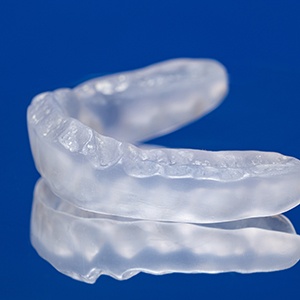TMJ Treatment – Lewisville
Put an End to Jaw Pain

Does your jaw pop, click, or hurt when you chew your food? Do you experience frequent headaches or earaches? You may have temporomandibular joint dysfunction (TMD). This is when the jaw joints aren’t functioning properly, leaving you will a multitude of uncomfortable symptoms. Fortunately, we offer TMJ treatment to give you some relief. Continue reading to learn more about TMD and what we can do to help.
What Is TMJ Dysfunction?

Your TMJ, also known as your temporomandibular joint, is a set of small hinges located in front of your ears. This joint allows your lower jaw to move up and down when you speak, laugh, and talk. The TMJ is one of the most complex joints in the entire body, so it can be disturbed by misaligned bite, teeth grinding, and other factors. When it happens, you have TMJ dysfunction, or TMD.
Symptoms of TMJ Dysfunction

There are various symptoms that can arise from TMD. Here are some of the most common ones:
- Headaches: Once of the most underdiagnoses causes of frequent headaches or even migraines is TMD. The jaw muscles become tense, strained, and overworked, so it’s easy for this to affect the nearby muscles in the head.
- Ear Pain/Tinnitus: Since the TMJ is so close to the ears, a dysfunctional joint can easily cause ear pain. It can also cause ringing in the ears, known as tinnitus.
- Face/Jaw Pain: Jaw stiffness and pain are the most common symptoms of TMD. It can be hard to chew comfortably, and lockjaw is common.
- Bruxism: Teeth clenching and grinding can be caused by daily stress, a misaligned bite, and TMD. It usually happens during sleep and can overwork the jaw muscles, leading to additional pain.
Types of TMJ Treatment

Depending on the severity and cause of your TMD, there are several treatment options available. Here are the popular options that we offer.
Occlusal Splint
An occlusal splint is a customized orthotic device that can be worn to reduce the prevalence of TMD symptoms. Each mouthguard is individually made for each patient and needs to be worn during sleep. It works by shifting your jaw into its ideal position to relieve your joints of additional strain and stress. It can also reduce the harmful effects of teeth grinding and clenching.
Equilibration/Occlusal Adjustment
If the cause of your TMD pain is bite misalignment or an improperly placed restoration, we might suggest occlusal adjustments. During this time, we will strategically and gently reshape your teeth so they come together in a more functional manner that doesn’t cause your joints to be strained. To pinpoint the area of your bit that may be under additional pressure, we’ll take an impression of your teeth and gently buff them down for lasting relief.
TMJ Treatment FAQs
Can TMJ Be Cured Permanently?
Discomfort associated with TMJ disorder can sometimes go away on its own overtime. However, if your symptoms are starting to impact your everyday life, you should see a professional for help. Some TMJ treatment methods, like occlusal splints and equilibration/occlusal adjustments, are designed to permanently address jaw tension, misalignment, or other underlying causes of TMD, providing you with lasting relief.
Is TMJ Treatment Safe?
Once your TMJ treatment is performed by a qualified professional, it is perfectly safe. It is generally recommended that TMJ disorder is treated with as minimally invasive and conservative methods as possible. That’s why several possibilities are typically recommended before undergoing surgery, which comes with additional risks. Occlusal splints and equilibration/occlusal adjustments have all been proven to be overwhelmingly safe for addressing TMD.
How Long Does It Take for a TMJ Splint to Work?
Occlusal splints for TMD are usually worn to bed at night. You may notice that your symptoms subside very quickly, but they won’t go away all at once. It takes time for the TMJs and surrounding areas to adjust to their new, healthier positions. After about six weeks, most patients experience notable improvement, but not full relief. It usually takes three to six months for an occlusal splint to resolve TMD discomfort. Just keep in mind that everyone is different, and some people may experience shorter or longer recovery times.
Does Occlusal Adjustment for TMJ Hurt?
Everyone’s treatment looks a little bit different, but no matter what yours consists of, we will ensure that your experience is comfortable for each step along the way. Occlusal adjustment is usually performed by precisely filing down the biting surface of the teeth or restorations that protrude and throw off the bite’s overall balance. A small dental drill is used to remove small amounts of enamel, relieving the stress that’s on your jaw joints. In some cases, dental structure may need to be added using composite resin. Depending on your situation, you may or may not need a local anesthetic. You may experience some soreness for a few days afterward, but this should be mild and temporary.
Do Mouthguards Really Help TMJ?
Athletic mouthguards aren’t designed to help with TMD. However, occlusal splints, sometimes referred to as “TMJ mouthguards,” are crafted to help the jaw and facial muscles relax. It can also prevent the upper and lower teeth from touching each other during teeth grinding and clenching. This can protect your enamel and reduce jaw pain associated with bruxism. Depending on your situation, an occlusal splint may be the ideal way to address your TMD.
